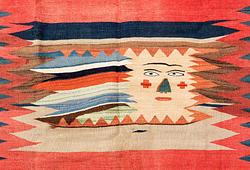Carl Milles
"Europa och tjuren" (Europa and the bull)
Painted/marbled plaster. Length 69, height 79 cm.
Literature
M.P. Verneuil, "Carl Milles. Sculpteur suédois", 1929, jmfr sid 52-54.
Henrik Cornell, "Milles skönhetsvärld", 1957, jmfr sid 70-75 nr 13-17.
Henrik Cornell, "Carl Milles", SAK, 1963, jmfr sid 54-62.
Meyric R. Rogers, "Carl Milles. An interpretation of his work", 1973, jmfr sid 24-25, plate 33-37.
Erik Näslund, "Carl Milles. En biopgrafi", 1991, jmfr sid 192-195.
More information
I monumentalformat finns "Europa och tjuren som fontänskulptur i Halmstad uppförd år 1926 samt en replik har senare uppförts på Millesgården.
Designer
Carl Milles was a Swedish sculptor born in Lägga. He studied at the Technical School in Stockholm, at the Ecole des Beaux-Arts in Paris under Auguste Rodin and on study trips to Germany, the Netherlands and Belgium. In Paris he came to stay for many years and made a living as an ornament carver. He studied the animals in the Jardin des Plantes (the Zoological Garden) and was strongly influenced by Auguste Rodin. Milles made a breakthrough with a monument to Sten Sture in Uppsala. He exhibited at the World's Fair in 1900 and was later given a solo exhibition at the Tate Gallery in London. Milles was professor of modeling at the Royal Academy of Arts in Stockholm. Well-known sculptures in public places signed by Carl Milles are the "Gustav Vasa" statue at the Nordic Museum, "Orfeusgruppen" outside the concert hall in Stockholm and the "Poseidonfontänen" in Gothenburg.
Read more


























